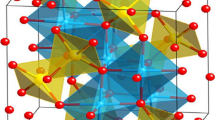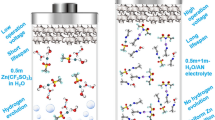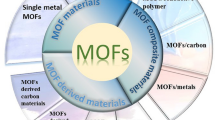Abstract
Modulating the oxidation states of transition metal species has been regarded as a promising strategy to tune the redox activity and achieve more active sites in electrode materials. In this work, a unique three-dimensional (3D) honeycomb-like cobalt sulfide (CoxSy) network organized by cross-linked nanosheets (CoxSy-T NSs) was prepared via a simple triethanolamine (TEOA)-assisted self-templating strategy. Interestingly, it has been found for the first time that the introduction of TEOA in the reaction effectively increases the ratio of high-valence Co3+ in the final product. Benefiting from the synergetic effect of the tailored high-valence Co3+ with the 3D network structure, the CoxSy-T NS electrode exhibits a maximum specific capacity of 351 mAhg−1 (2635 F g−1) at 5 A g−1 as well as excellent cycling stability. Furthermore, with the solid-state asymmetric supercapacitor (ASC) constructed based on the CoxSy-T NSs and activated carbon (AC) electrodes, a high energy density up to 81.62 W h kg−1 has been achieved at the power density of 0.81 kW kg−1 and 96.2% capacitance is preserved after 7000 cycles, indicating robust cycling stability. This result high lights the simple approach of simultaneously tailoring high valence metal species and constructing 3D network structure toward high performance electrode materials for energy sto rage and conversion.
摘要
过渡金属氧化态调控工程是一种很有前景的改善电极材料的 氧化还原活性、增加活性位点的策略. 本文提出了一种简单的三乙 醇胺辅助自模板法, 制备了一种由交错钴硫化物纳米片(CoxSy-T NSs)组装而成的独特的三维蜂窝状网络结构. 有趣的是, 我们首次 发现在该体系中, 三乙醇胺可以有效地增加目标产物中的高价态 Co3+的比例. CoxSy-T NSs电极具有高含量的Co3+和三维网络结构, 使得其在5 A g−1的电流密度下表现出351 mA h g−1(2635 F g−1)的最 大比容量和优异的循环稳定性. 此外, 由CoxSy-T NSs和活性炭(AC) 电极组装的固态不对称超级电容器在0.81 kW kg−1功率密度下展现 出81.62 W h kg−1的高能量密度和卓越的长周期循环稳定性, 7000次 循环后仍有96.2%的容量保持率. 该结果证明同时调控高价态的金属 物种并构筑三维网络结构是一种简单而有效的制备用于能源存储 与转换的高活性电极材料的策略.
Similar content being viewed by others
References
Yang P, Mai W. Flexible solid-state electrochemical supercapacitors. Nano Energy, 2014, 8: 274–290
Chen Z, Yang Y, Ma Z, et al. All-solid-state asymmetric supercapacitors with metal selenides electrodes and ionic conductive composites electrolytes. Adv Funct Mater, 2019, 29: 1904182
Gao S, Sun Y, Lei F, et al. Ultrahigh energy density realized by a single-layer β-Co(OH)2 all-solid-state asymmetric supercapacitor. Angew Chem Int Ed, 2014, 53: 12789–12793
Simon P, Gogotsi Y, Dunn B. Where do batteries end and supercapacitors begin? Science, 2014, 343: 1210–1211
Wang H, Deng J, Xu C, et al. Ultramicroporous carbon cloth for flexible energy storage with high areal capacitance. Energy Storage Mater, 2017, 7: 216–221
Flouda P, Shah SA, Lagoudas DC, et al. Highly multifunctional dopamine-functionalized reduced graphene oxide supercapacitors. Matter, 2019, 1: 1532–1546
Lv T, Liu M, Zhu D, et al. Nanocarbon-based materials for flexible all-solid-state supercapacitors. Adv Mater, 2018, 30: 1705489
Gao Y, Wan Y, Wei B, et al. Capacitive enhancement mechanisms and design principles of high-performance graphene oxide-based all-solid-state supercapacitors. Adv Funct Mater, 2018, 28: 1706721
Lu W, Shen J, Zhang P, et al. Construction of CoO/Co-Cu-S hierarchical tubular heterostructures for hybrid supercapacitors. Angew Chem Int Ed, 2019, 58: 15441–15447
Liu H, Liu X, Wang S, et al. Transition metal based battery-type electrodes in hybrid supercapacitors: A review. Energy Storage Mater, 2020, 28: 122–145
Shen L, Yu L, Wu HB, et al. Formation of nickel cobalt sulfide ballin-ball hollow spheres with enhanced electrochemical pseudocapacitive properties. Nat Commun, 2015, 6: 6694
Niu H, Zhang Y, Liu Y, et al. MOFs-derived Co9S8-embedded graphene/hollow carbon spheres film with macroporous frameworks for hybrid supercapacitors with superior volumetric energy density. J Mater Chem A, 2019, 7: 8503–8509
Liu Q, Hong X, Zhang X, et al. Hierarchically structured Co9S8@NiCo2O4 nanobrushes for high-performance flexible asymmetric supercapacitors. Chem Eng J, 2019, 356: 985–993
Mao X, He X, Yang W, et al. Hierarchical holey Co9S8@S-rGO hybrid electrodes for high-performance asymmetric supercapacitors. Electrochim Acta, 2019, 328: 135078
Lu W, Yuan Z, Xu C, et al. Construction of mesoporous Cu-doped Co9S8 rectangular nanotube arrays for high energy density all-solid-state asymmetric supercapacitors. J Mater Chem A, 2019, 7: 5333–5343
Wang H, Fan R, Miao J, et al. Oxygen vacancies on the surface of HxWO3−y for enhanced charge storage. J Mater Chem A, 2018, 6: 6780–6784
Li S, Zhang Y, Liu N, et al. Operando revealing dynamic reconstruction of NiCo carbonate hydroxide for high-rate energy storage. Joule, 2020, 4: 673–687
Tang Y, Li X, Lv H, et al. Stabilized Co3+/Co4+ redox pair in in situ produced CoSe2−x-derived cobalt oxides for alkaline Zn batteries with 10000-cycle lifespan and 1.9-V voltage plateau. Adv Energy Mater, 2020, 10: 2000892
Zhang Y, Liu C, Gao X, et al. Revealing the activation effects of high valence cobalt in CoMoO4 towards highly reversible conversion. Nano Energy, 2020, 68: 104333
Sun H, Mei L, Liang J, et al. Three-dimensional holey-graphene/niobia composite architectures for ultrahigh-rate energy storage. Science, 2017, 356: 599–604
Wang H, Xu C, Chen Y, et al. MnO2 nanograsses on porous carbon cloth for flexible solid-state asymmetric supercapacitors with high energy density. Energy Storage Mater, 2017, 8: 127–133
Zhu Z, Lin J, Li N, et al. Porous Co9S8 nanosheet arrays@Co foam electrode via in situ sulfidation at room temperature for superior supercapacitors. J Phys Chem C, 2020, 124: 83–91
Xu C, Lu W, Yan L, et al. Hierarchical molybdenum-doped cobaltous hydroxide nanotubes assembled by cross-linked porous nanosheets with efficient electronic modulation toward overall water splitting. J Colloid Interface Sci, 2020, 562: 400–408
Wang H, Chen Y, Fan R, et al. Selective electrochemical reduction of nitrogen to ammonia by adjusting the three-phase interface. Research, 2019, 2019: 1401209
Yan L, Wang H, Shen J, et al. Formation of mesoporous Co/CoS/Metal-N-C@S, N-codoped hairy carbon polyhedrons as an efficient trifunctional electrocatalyst for Zn-air batteries and water splitting. Chem Eng J, 2021, 403: 126385
Yang Y, Ma Q, Han L, et al. Zeolitic imidazolate framework-derived Co3S4@Co(OH)2 nanoarrays as self-supported electrodes for asymmetric supercapacitors. Inorg Chem Front, 2019, 6: 1398–1404
Zhang Z, Huang Y, Liu X, et al. Zeolitic imidazolate frameworks derived ZnS/Co3S4 composite nanoparticles doping on polyhedral carbon framework for efficient lithium/sodium storage anode materials. Carbon, 2020, 157: 244–254
Lu F, Zhou M, Li W, et al. Engineering sulfur vacancies and impurities in NiCo2S4 nanostructures toward optimal supercapacitive performance. Nano Energy, 2016, 26: 313–323
Deng S, Zhong Y, Zeng Y, et al. Hollow TiO2@Co9S8 core-branch arrays as bifunctional electrocatalysts for efficient oxygen/hydrogen production. Adv Sci, 2018, 5: 1700772
Cao Y, Lu H, Xu B, et al. Nitrogen/sulfur dual-doped porous carbon nanofibers with Co9S8 nanoparticles encapsulated by graphitic shells: A highly active stable free-standing air electrode for rechargeable non-aqueous Li-O2 batteries and primary alkaline Alair batteries. Chem Eng J, 2019, 378: 122247
Wang X, Huang F, Rong F, et al. Unique MOF-derived hierarchical MnO2 nanotubes@NiCo-LDH/CoS2 nanocage materials as high performance supercapacitors. J Mater Chem A, 2019, 7: 12018–12028
Li Q, Lu W, Li Z, et al. Hierarchical MoS2/NiCo2S4@C urchin-like hollow microspheres for asymmetric supercapacitors. Chem Eng J, 2020, 380: 122544
Kandula S, Shrestha KR, Kim NH, et al. Fabrication of a 3D hierarchical sandwich Co9S8/α-MnS@N-C@MoS2 nanowire architectures as advanced electrode material for high performance hybrid supercapacitors. Small, 2018, 14: 1800291
Li Z, Zhao D, Xu C, et al. Reduced CoNi2S4 nanosheets with enhanced conductivity for high-performance supercapacitors. Electrochim Acta, 2018, 278: 33–41
Zhang S, Li D, Chen S, et al. Highly stable supercapacitors with MOF-derived Co9S8/carbon electrodes for high rate electrochemical energy storage. J Mater Chem A, 2017, 5: 12453–12461
Manjakkal L, Pullanchiyodan A, Yogeswaran N, et al. A wearable supercapacitor based on conductive PEDOT:PSS-coated cloth and a sweat electrolyte. Adv Mater, 2020, 32: 1907254
Kim HS, Cook JB, Lin H, et al. Oxygen vacancies enhance pseudocapacitive charge storage properties of MoO3−x. Nat Mater, 2017, 16: 454–460
Liu P, Gao Y, Tan Y, et al. Rational design of nitrogen doped hierarchical porous carbon for optimized zinc-ion hybrid supercapacitors. Nano Res, 2019, 12: 2835–2841
Sun S, Luo J, Qian Y, et al. Metal-organic framework derived honeycomb Co9S8@C composites for high-performance supercapacitors. Adv Energy Mater, 2018, 8: 1801080
Liang M, Zhao M, Wang H, et al. Superior cycling stability of a crystalline/amorphous Co3S4 core-shell heterostructure for aqueous hybrid supercapacitors. J Mater Chem A, 2018, 6: 21350–21359
Yang X, Sun H, Zan P, et al. Growth of vertically aligned Co3S4/CoMo2S4 ultrathin nanosheets on reduced graphene oxide as a high-performance supercapacitor electrode. J Mater Chem A, 2016, 4: 18857–18867
He W, Wang C, Li H, et al. Ultrathin and porous Ni3S2/CoNi2S4 3D-network structure for superhigh energy density asymmetric supercapacitors. Adv Energy Mater, 2017, 7: 1700983
Surendran S, Shanmugapriya S, Sivanantham A, et al. Electrospun carbon nanofibers encapsulated with NiCoP: A multifunctional electrode for supercapattery and oxygen reduction, oxygen evolution, and hydrogen evolution reactions. Adv Energy Mater, 2018, 8: 1800555
Liu Y, Wang Z, Zhong Y, et al. Molecular design of mesoporous NiCo2O4 and NiCo2S4 with sub-micrometer-polyhedron architectures for efficient pseudocapacitive energy storage. Adv Funct Mater, 2017, 27: 1701229
Liu Q, Hong X, You X, et al. Designing heterostructured metal sulfide core-shell nanoneedle films as battery-type electrodes for hybrid supercapacitors. Energy Storage Mater, 2020, 24: 541–549
Syed JA, Ma J, Zhu B, et al. Hierarchical multicomponent electrode with interlaced Ni(OH)2 nanoflakes wrapped zinc cobalt sulfide nanotube arrays for sustainable high-performance supercapacitors. Adv Energy Mater, 2017, 7: 1701228
Liu S, Yin Y, Ni D, et al. New insight into the effect of fluorine doping and oxygen vacancies on electrochemical performance of Co2MnO4 for flexible quasi-solid-state asymmetric supercapacitors. Energy Storage Mater, 2019, 22: 384–396
Yu F, Chang Z, Yuan X, et al. Ultrathin NiCo2 S4@graphene with a core-shell structure as a high performance positive electrode for hybrid supercapacitors. J Mater Chem A, 2018, 6: 5856–5861
Chen W, Xia C, Alshareef HN. One-step electrodeposited nickel cobalt sulfide nanosheet arrays for high-performance asymmetric supercapacitors. ACS Nano, 2014, 8: 9531–9541
Shen L, Wang J, Xu G, et al. NiCo2S4 nanosheets grown on nitrogen-doped carbon foams as an advanced electrode for supercapacitors. Adv Energy Mater, 2015, 5: 1400977
Yang Q, Wang Q, Long Y, et al. In situ formation of Co9S8 quantum dots in MOF-derived ternary metal layered double hydroxide nanoarrays for high-performance hybrid supercapacitors. Adv Energy Mater, 2020, 10: 1903193
He W, Liang Z, Ji K, et al. Hierarchical Ni-Co-S@Ni-W-O core-shell nanosheet arrays on nickel foam for high-performance asymmetric supercapacitors. Nano Res, 2018, 11: 1415–1425
Acknowledgements
This work was supported by the National Natural Science Foundation of China (21671173) and Zhejiang Provincial Ten Thousand Talent Program (2017R52043).
Author information
Authors and Affiliations
Contributions
Wang H and Hu Y designed the project; Wang H, Yang Y and Li Q performed the experiments; Wang H analyzed the data and wrote the paper with support from Hu Y; Lu W assisted in the data analysis; Ning J, Zhong Y, and Zhang Z gave pivotal advice. All authors contributed to the general discussion.
Corresponding author
Additional information
Conflict of interest
The authors declare that they have no conflict of interest.
Haiyan Wang received her PhD degree in 2018 from Zhejiang University. From 2018 to 2019, she was a postdoctoral fellow at Zhejiang University and then she joined Zhejiang Normal University as a lecturer in 2019. Her interests mainly focus on electrode materials for energy storage and conversion devices, including supercapacitors, Zn-air batteries and water splitting.
Ying Yang is currently a graduate student under the guidance of Professor Yong Hu from the Department of Chemistry, Zhejiang Normal University. Her research interests focus on the design and manufacture of inorganic nanomaterials for supercapacitors and ionic hybrid supercapacitors.
Qinghao Li received his B. Eng degree in chemical engineering from Jiangxi University of Science and Technology and his MSc degree in chemistry from Zhejiang Normal University. His research interests include supercapacitors and electrochemical water splitting.
Yong Hu obtained his PhD degree in 2006 in inorganic chemistry from the University of Science and Technology of China. He then worked as a research fellow at Nanyang Technological University. Since 2008, he has been a full professor at the College of Chemistry and Life Science, Zhejiang Normal University, China. His current research interests are focused on the design and syntheses of nanomaterials for energy and environmental applications.
Supporting Information
40843_2020_1476_MOESM1_ESM.pdf
Molecule-assisted modulation of the high-valence Co3+ in 3D honeycomb-like CoxSy networks for high-performance solid-state asymmetric supercapacitors
Rights and permissions
About this article
Cite this article
Wang, H., Yang, Y., Li, Q. et al. Molecule-assisted modulation of the high-valence Co3+ in 3D honeycomb-like CoxSy networks for high-performance solid-state asymmetric supercapacitors. Sci. China Mater. 64, 840–851 (2021). https://doi.org/10.1007/s40843-020-1476-2
Received:
Accepted:
Published:
Issue Date:
DOI: https://doi.org/10.1007/s40843-020-1476-2




